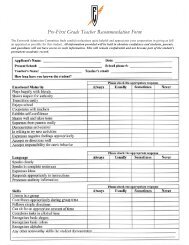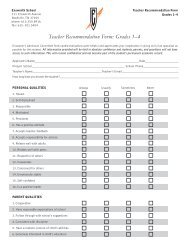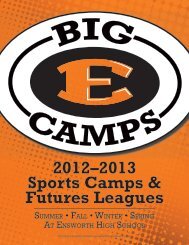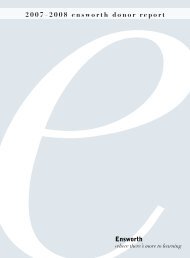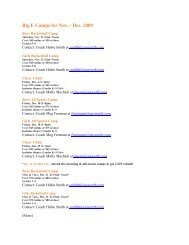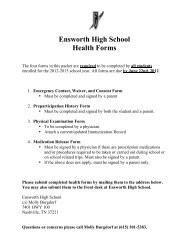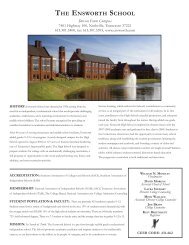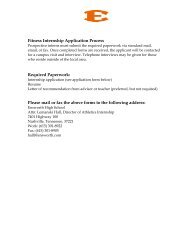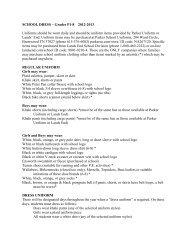individual narrative report score interpretation folder - Ensworth School
individual narrative report score interpretation folder - Ensworth School
individual narrative report score interpretation folder - Ensworth School
You also want an ePaper? Increase the reach of your titles
YUMPU automatically turns print PDFs into web optimized ePapers that Google loves.
INDIVIDUAL NARRATIVE REPORT<br />
SCORE INTERPRETATION FOLDER
WHAT DOES THIS<br />
REPORT TELL YOU<br />
The Individual Narrative Report that your<br />
child’s school has given to you with this<br />
<strong>folder</strong> describes your son’s or daughter’s<br />
performance on the CTP tests. The <strong>report</strong><br />
contains three kinds of information about<br />
your child’s performance on the tests:<br />
• The upper part of the <strong>report</strong> contains<br />
a table showing your child’s relative<br />
position on each test in one or more<br />
groups called “norm groups.”<br />
• The middle part of the <strong>report</strong> contains<br />
a graph showing a “probable range”<br />
for your child’s relative position on<br />
each test in one of the norm groups.<br />
• The lower part of the <strong>report</strong> briefly<br />
describes each of the tests your<br />
child took.<br />
The purpose of this <strong>folder</strong> is to explain<br />
the statistics that describe your child’s<br />
performance and to provide more<br />
information about the tests. To help you<br />
understand your child’s <strong>report</strong>, this <strong>folder</strong><br />
includes a similar <strong>report</strong> for a fictitious<br />
student, Michael, a seventh-grader who took<br />
the CTP tests.<br />
WHAT IS A<br />
NORM GROUP<br />
A norm group is a group of students with<br />
whom your child is being compared—<br />
usually other students in the same grade.<br />
The <strong>report</strong> for Michael includes statistics<br />
that compare his performance with that<br />
of three different norm groups.<br />
• The suburban norm group consists of<br />
students in suburban public schools<br />
that use the CTP tests. For each test that<br />
Michael took, the suburban norm group<br />
includes all the seventh-grade students<br />
in those suburban schools who took that<br />
test during the three previous years.<br />
• The independent norm group consists of<br />
students in independent schools that use<br />
the CTP tests. For each test that Michael<br />
took, the independent norm group<br />
includes all the seventh-grade students in<br />
those independent schools who took that<br />
test during the three previous years.<br />
• The national norm group includes all the<br />
students at the appropriate grade level in<br />
all schools in the nation— large and small<br />
schools; rich and poor schools; urban,<br />
suburban, and rural schools. The statistics<br />
for the national norm group are estimates<br />
based on data from a scientifically<br />
selected sample of schools that<br />
administered the CTP 4 tests in a special<br />
“national norming” study conducted. For<br />
each test that Michael took, the national<br />
norm group statistics are estimates<br />
that show how his performance would<br />
compare with the <strong>score</strong>s that would have<br />
resulted if all the seventh-grade students<br />
in the nation had taken that test during<br />
their seventh-grade year.<br />
WHAT IS A<br />
PERCENTILE RANK<br />
A percentile rank is one way of<br />
comparing your child’s performance<br />
with the performance of a norm group.<br />
Your child’s percentile rank is the<br />
percentage of the norm group who had<br />
lower <strong>score</strong>s than your child (plus half<br />
the percentage who had exactly the<br />
same <strong>score</strong> as your child). A student who<br />
performed better than 70 percent of the<br />
norm group but not as well as the other<br />
30 percent would have a percentile rank<br />
of 70 in that norm group.<br />
A percentile rank does not indicate the<br />
percentage of the questions that your<br />
child answered correctly. The percentile<br />
rank is a percentage of students in a<br />
norm group. Michael's quantitative<br />
reasoning <strong>score</strong> had a percentile rank<br />
of 60 in the independent norm group. In<br />
other words, his quantitative reasoning<br />
<strong>score</strong> was higher than the <strong>score</strong>s of<br />
60 percent of the seventh-grade students<br />
at independent schools who took the CTP<br />
quantitative reasoning test in the fall of the<br />
three previous years.<br />
Because some norm groups perform better<br />
than others, your child’s percentile rank will<br />
differ from one norm group to another. A<br />
student’s percentile rank will be lower in a<br />
stronger norm group and higher in a weaker<br />
norm group. The students in schools using<br />
the CTP tests tend to be an academically<br />
strong group in comparison to all students in<br />
the nation. Although Michael's quantitative<br />
reasoning <strong>score</strong> had a percentile rank of 60<br />
in the independent norm group, it had a<br />
percentile rank of 89 in the national norm<br />
group.<br />
WHAT IS A STANINE<br />
A stanine is another way of comparing<br />
your child’s performance with the<br />
performance of a norm group. Stanines<br />
are formed by dividing the students in<br />
the norm group into nine subgroups<br />
on the basis of their test <strong>score</strong>s. These<br />
subgroups are called “stanines” and<br />
are numbered 1 to 9, lowest to highest.<br />
The nine subgroups are not all the same<br />
size. The middle stanines include more<br />
students; those at the ends include<br />
fewer students. Stanine 5 is the largest;<br />
stanines 1 and 9 are the smallest. The<br />
following table shows the percentage<br />
of the students in the norm group who<br />
are in each stanine. Because these<br />
percentages are always the same, each<br />
stanine is associated with a range of<br />
percentile ranks. Those percentile<br />
ranks are also shown in the table.<br />
STANINE PERCENTAGE PERCENTILE<br />
OF STUDENTS RANKS<br />
9 4 96-99<br />
8 7 89-95<br />
7 12 77-88<br />
6 17 60-76<br />
5 20 40-59<br />
4 17 23-39<br />
3 12 11-22<br />
2 7 4-10<br />
1 4 1-3
A student in stanine 5 of a norm group has performed about as well as the average student in the norm group. In general, the middle<br />
three categories—stanines 4, 5, and 6—can be considered to represent average performance for that norm group; stanines 1, 2, and<br />
3 can be considered to represent below-average performance for that norm group; stanines 7, 8, and 9 can be considered to represent<br />
above-average performance for the norm group.<br />
Because some norm groups perform better than others, your child’s stanine can be different in different norm groups. Typically,<br />
your child’s stanine will be lower in a stronger norm group and higher in a weaker norm group. The stanine is not a very precise<br />
measure. The reason is that two percentile ranks may be very close to the borderline between one stanine and another stanine,<br />
but one may be just below the borderline and the other just at it. Before concluding that a difference between your child’s stanines<br />
on two different tests is meaningful, look at the percentile ranks. Then look at the table to see if either of the <strong>score</strong>s was nearly in a<br />
different stanine.<br />
WHAT ARE LEXILE ® AND QUANTILE ® MEASURES<br />
You may see <strong>report</strong>ed Lexile and Quantile measures on your child’s <strong>report</strong>. A Lexile measure represents your child’s reading ability<br />
and can be used to match him or her with books and other materials at an appropriate difficulty level. A Quantile measure describes<br />
your child’s mathematical ability and can be used to determine his or her readiness to learn new mathematical skills and concepts.<br />
Please visit erblearn.org/ctp for more information.<br />
WHAT IS A “PROBABLE RANGE”<br />
The graph in the middle of the <strong>report</strong> contains<br />
a set of horizontal bars, with a black diamond<br />
near the center of each bar. The black diamond<br />
indicates your child’s percentile rank on one of the<br />
tests. The bar represents a “probable range” for<br />
that percentile rank.<br />
The concept of a “probable range” is based on<br />
the idea that the questions on a CTP test are not<br />
the only questions that could have been used.<br />
Many other questions could have been written<br />
to test the skills and the types of knowledge that<br />
the test measures. The questions on the test can<br />
be thought of as only a sample from a very large<br />
number of questions that could have been used.<br />
If a different selection of questions had been used<br />
on the test, your child’s percentile rank might<br />
have been somewhat different. The bar indicates<br />
how different your child’s percentile rank might<br />
plausibly have been. If the bars for two tests do not<br />
overlap, it is not likely that the higher of those two<br />
percentile ranks would have been lower if different<br />
questions had been used on those two tests. But if<br />
there is a substantial overlap between the bars for<br />
two tests, the difference between those percentile<br />
ranks might well have been in the other direction<br />
if different questions had been used.<br />
FPO -<br />
will replace with new<br />
once received.<br />
A FINAL NOTE<br />
Interpreting test <strong>score</strong>s can be complex. We hope<br />
we have succeeded in helping you understand the<br />
meaning of your child’s test results. If you still have any<br />
unanswered questions, the staff at your child’s school<br />
will be glad to help you.
DESCRIPTION OF CTP TESTS<br />
Verbal Reasoning: the ability to analyze information and draw logical inferences,<br />
to recognize analogical verbal relationships, and to generalize verbal categorical attributes<br />
LEVEL<br />
3-10<br />
Auditory Comprehension: prereading vocabulary and comprehension of orally presented<br />
material, understanding of stated information, the ability to determine the gist of short passages,<br />
and the ability to infer information based on these passages<br />
Vocabulary: recognition and understanding of a wide range of grade-appropriate vocabulary<br />
and use of context clues to determine meaning<br />
3<br />
4-10<br />
Reading Comprehension: comprehension of written material, including recall of information,<br />
identifying of main ideas, and hypothesizing using information from passages<br />
3-10<br />
Writing Mechanics: understanding of spelling, capitalization, punctuation, and usage conventions<br />
Writing Concepts and Skills: understanding of the components of effective written composition<br />
Mathematics: conceptual understanding of mathematics, application of mathematical<br />
knowledge to solve problems, and the ability to compute or estimate solutions<br />
3-10<br />
3-10<br />
3-10<br />
Quantitative Reasoning: the ability to analyze mathematical concepts and principles, to make<br />
generalizations, and to compare quantities mathematically<br />
3-10<br />
Algebra I: skills typically taught in Algebra I with emphasis on problem solving and operations with<br />
variables, equations, and algebraic geometry<br />
8, 9<br />
Science: understanding scientific process skills, energy, forces and motion, space systems, physical<br />
and chemical properties, the living environment and the living organism<br />
3-10<br />
MetaMetrics®, the MetaMetrics® logo and tagline, Lexile®, Lexile Framework®, Lexile Analyzer®, the Lexile® logo, Quantile®, Quantile Framework® and the Quantile® logo are<br />
trademarks of MetaMetrics, Inc., and are registered in the United States and abroad.<br />
• www.erblearn.org<br />
Copyright © 2012 by Educational Records Bureau. All rights reserved.<br />
81172-023004 • Y109E.001 • Printed in U.S.A.



